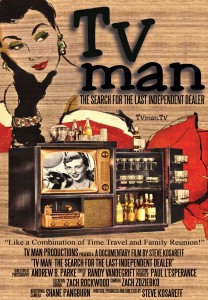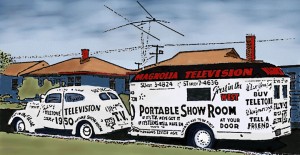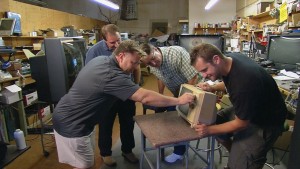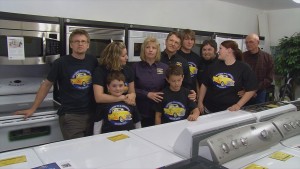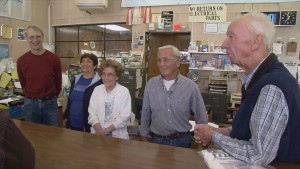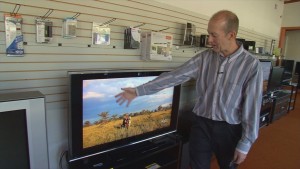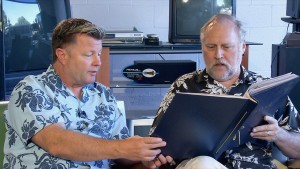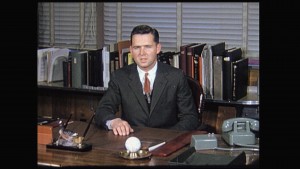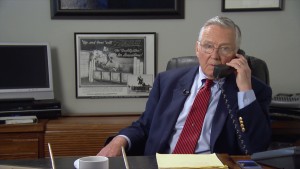Presents
“TV Man: the Search For The Last Independent Dealer”
A film by Steve Kosareff
Written, Produced and Directed by
Steve Kosareff
Edited by
Randy Vandegrift
Director of Photography
Andrew B. Parke
Executive Producer
Paul L’Esperance
Location Sound
Zach Rockwood
Second Camera
Zach Zdziebko
Additional Camera
Shane Pangburn
CAST
Poma TV – Ukiah, California
David Poma
Bruce Poma
Tim Poma
Central TV & Appliances – Chehalis, Washington
Doris “Pat” Swart
Joanne Sullivan
Roy Sahlin
Wally Lundeen
Richard T. Freeborn
Larry Gerard
Williams TV – Oroville, California
Gregory Williams
Joanna Williams
Robby Quedens
Hutchins TV & Appliances – Hillsboro, Oregon
Susie Swanson
Jim Swanson
Bill Phillips
Vern L. Wenger TV – Portland, Oregon
Randy Wenger
Nathan Rider
And
Electrical Distribution, Inc. (EDI) – Portland, Oregon
A.M. “Bubby” Cronin, III
“TV Man: the Search for the Last Independent Dealer”
Television expert and author Steve Kosareff’s beloved, childhood television set doesn’t work. Is there an independent TV dealer left in the United States that can fix it? Thus begins a 1,000 mile odyssey to find a dealer and discover what happened to the once-mighty industry.
Backpacking
Along with most baby boomers, Steve Kosareff and television grew up together. A collector of television ephemera from an early age, Kosareff’s professional interest in the medium—and TV Man’s genesis—can be traced back to a museum project. The Internet’s explosive growth in 1998 set the stage for Kosareff to meet two well-know television set collectors, Ed Reitan and Steve Dichter. He marveled at their unique sets and related ephemera and was inspired to develop an American museum devoted to the medium. Although the project did not come to fruition, Kosareff continued his research and it resulted in a manuscript on the history of the television medium. Published by Chronicle books in 2005, “Window to the Future: the Golden Age of Television Marketing and Advertising,” recalls the excitement of what is fondly remembered and of interest to many people: owning their first television set. The book features advertisements and marketing illustrations for many of these nostalgic sets and recounts how manufacturers marketed them to the public. It covers a hundred year period from 1870 to 1970, and in particular, the 1950s, considered by Kosareff to be the Golden Age of the medium. The marketing materials and ads in Window to the Future are from Kosareff’s collection and selected for their historical significance, production values, and/or their clever and unique ways of selling television sets. https://www.facebook.com/WindowToTheFuture
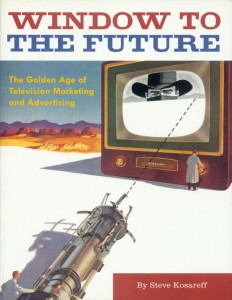
While Window to the Future” focused solely on marketing and advertising television sets, Kosareff began to research the selling of sets where the most‑prominent players were the dealers and distributors. He began to conceive a documentary film project to locate some of the remaining TV men and women, not only in hope of repairing his beloved childhood television set, but also to find out what happened to the industry which burned brightly for three decades and then disappeared altogether. Targeting the Pacific Northwest, Kosareff and a film crew shot TV Man in the Northern California towns of Ukiah and Oroville, Portland, Oregon and Chehalis, Washington. With the aid of archival film and photographs and the dealers’ own stories, TV Man is a warm, humorous, revealing look at retailing and repairing television sets and an industry that was once the pride of American manufacturing.
The Search
TV Man director Steve Kosareff sold Christmas cards to purchase his first set. A 12-inch black-and-white portable, it was named the Jetlite by its manufacturer, the Zenith Radio Corporation of Chicago. In the 1950s Zenith was the second largest of over one hundred American television set manufacturers.
By 1995 it would be the last.
Kosareff still owns the Jetlite which sat for years in his bedroom closet. Prompted by nostalgia, he pulls it out and plugs it in. It doesn’t work. Is there a local dealer that can fix the Jetlite? Kosareff locates a prospect through a 1950s ad he finds on the Internet for dealer Lloyd Dennee with seven stores. Could any of the stores still be open? He checks out the locations in person and discovers that, like Zenith, Dennee’s seven stores have also disappeared. Is there any dealer left in the United States that can fix the set? A second search produces possibilities, but the closest are 1,000 miles away in the Pacific Northwest. The Jetlite is Kosareff’s most-prized possession and he is determined to bring it back to life. Thus begins a road trip to fix the set, and more importantly, discover why there are so few dealers left in the country.
Kosareff visits five independent television set dealers and one distributor:
(1) Poma TV in Ukiah, California has been owned by one family, but changed locations five times over its 60-year history; not so unusual except the locations have all have been within a few blocks of each other in a small town with a population of eight to ten thousand;
(2) Hutchins TV & Appliance of Hillsboro, Oregon has been in business just as long as Poma, but unlike it, has had three owners in one location. Current owners, Jim and Susie Swanson and their adult children are a close‑knit family operation and Jim and son, Michael, were just a few away from being hit when a speeding car came crashing through the store window;
(3) Central TV & Appliance’s owner, Walt Swart passed away in 2006 but his widow, Pat, continues to operate the store with the able assist of longtime employees. Walt started the business with a fifty-foot storefront in 1952 but expanded over time by acquiring adjacent properties and even the old 1920s bank next door by jack‑hammering through three-foot thick concrete walls;
(4) The Vern L. Wenger Company has been in business for 90 years, first selling Victrolas, then radios, and finally, television sets. Like many other retailers during the 1950s and 60s, Wenger left its downtown core location for the suburbs and hasn’t looked back;
(5) Williams TV owner’s mis-prediction of Oroville’s outward growth mattered in the 1960s when the highway bypassed the store, but now the town’s aging and disappearing population has left son Greg Williams only repairing—not selling—television sets;
and (6) Bubby Cronin is the fourth-generation family manager to run Electrical Distributing, Inc., which was Portland, Oregon’s Zenith Radio & TV distributor for 61 years.
EDI got the boot by Zenith in 1995 just before it sold itself to Korean-owned LG Electronics. Bubby now faced the loss of a major part of its distribution business.
What did he do?
Oddly enough, many early television set dealers had their first encounters with receivers through tire stores they managed or owned. Lloyd Dennee, the dealer near Kosareff’s home, owned a Goodyear Tire store which featured a few sets just after World War II. Both Art Poma and Walt Swart also owned Firestone Tire stores. Farsighted dealers like Dennee, Poma and
Swart saw the future and it was television. They all opened stores catering to the new TV set culture which exploded during the 1950s. Even without great accounting skills (which often resulted in the loss of forgotten loaner sets) and much competition, dealers such as Art Poma could still make money during the decade and for years thereafter.
Unlike big box stores and discount chains today, independent dealers have always had special relationships with their communities. They know their customers by name because they drop in so often—even if it’s just for coffee and donuts. Susie Swanson recounts one such customer whose life was saved by one of her delivery drivers because they hadn’t seen him for a few days.
Walt Swart also acted as his own collection agency, repossessing unpaid merchandise and as security, running after a man with long hair who had stolen a radio and holding him by his ponytail in the getaway car until police relieved him. Swart was also known to take compensation other than money to pay for television sets and appliances such as pigs, goats and old organ. He also gave credit freely to the consternation of his office manager, Joanne.
During the early years of commercial television sets, tubes burned out frequently which required their owners to have ongoing relationships with repairmen. Many dealer sons grew up fixing this type of set and getting shocked—or nearly electrocuted—as a routine part of the business. Falling off a roof installing an antenna was also a hazard. So was being propositioned by housewives, when working in homes.
When remote controls came into wide use during the 1980s and 90s, dealers were inundated with phone calls from older people who had lost control of their sets. As the decades rolled on and TV sets lost their tube origins and began to look and operate more like computers, dealers, wanting to stay in business, were faced with learning new technologies. With the new world order of retail sales migrating to the Internet, many dealers, which were now shopped in‑store but clicked out of sales online, were forced to face a hard reality: stay and fight or shutter their doors.
One of TV Man’s dealers must make that hard choice.
The Creative Team
 Steve Kosareff (Writer/Producer/Director) When your mother told you not to sit too close to the television set—and she wasn’t looking—did you ever make face contact with the screen to try and capture the medium’s magic? Steve Kosareff did. He watched the fluorescent pixels as they changed from white to shades of gray, then black, and back to white, wondering how they worked in unison to create a picture. He picked up a book to find out why, eventually reading everything on the history of the medium he could find. Although he’s studied television for years, he still can’t repair a classic 1950s tube set. Nevertheless, his love for the medium endures and found professional outlets with Chronicle Books’ 2005 publication of “Window to the Future: the Golden Age of Television Marketing and Advertising,” and recently, the completion of his documentary feature, TV Man: the Search for the Last Independent Dealer.
Steve Kosareff (Writer/Producer/Director) When your mother told you not to sit too close to the television set—and she wasn’t looking—did you ever make face contact with the screen to try and capture the medium’s magic? Steve Kosareff did. He watched the fluorescent pixels as they changed from white to shades of gray, then black, and back to white, wondering how they worked in unison to create a picture. He picked up a book to find out why, eventually reading everything on the history of the medium he could find. Although he’s studied television for years, he still can’t repair a classic 1950s tube set. Nevertheless, his love for the medium endures and found professional outlets with Chronicle Books’ 2005 publication of “Window to the Future: the Golden Age of Television Marketing and Advertising,” and recently, the completion of his documentary feature, TV Man: the Search for the Last Independent Dealer.
“Window to the Future” was reviewed favorably in the American press. Long Island’s Newsday, ran a full-color double‑page spread in its Sunday “Fanfair” section, text of which was nationally syndicated to other Tribune‑owned newspapers including the Los Angeles Times. Vanity Fair also reviewed the book in its “Fanfair” column; other reviewing publications include the Academy of Television Arts & Sciences magazine, Emmy. “Window” has a following in Japan, Australia, Germany, England, France, Canada—countries with continuing interest in popular American culture—and of course, the United States. American artist Shepard Fairey is a fan and the book appears with him during his interview sequences in the documentary, Exit Through the Gift Shop.
TV Man is Mr. Kosareff’s first film. He is currently developing a film on singer-songwriter John Stewart (“Daydream Believer”). http://www.SteveKosareff.com
Randy Vandegrift (Editor) Randy Vandegrift’s motion picture editing career spans feature films, television series, documentaries, and 3D stereoscopic productions. Randy received a degree in film production from Penn State University in 1983. His editing career began in Hollywood with independent 35mm Sci-Fi film “The Final Hour” which was accepted to Los Angeles Filmex Festival in 1984. While he continued editing Randy produced “A Familiar Story” in 1989 winning awards from the Philadelphia International Film Festival (Philafilm), the New York Film Festival and 2 other competitions. In 1993 he edited “Young Goodman Brown” which received the Silver Award for Best Independent Film at the Houston International Film Festival. In 2011 Randy produced and edited action feature film “Out of Touch.” He associate produced “Home” which won Best Short Film at the Tirana International Film Festival and Best Cinematography at the Oaxaca Film Festival in 2012. “TV Man” is his 14th feature film as film editor. Website: http://www.2k4ktalkingpictures.com/index.html
Andrew B. Parke (Director of Photography) started his career as a film loader. After working on over 30 features as a first assistant cameraman starting with the television series, Unsolved Mysteries through the big budget theatrical features, Independence Day and Godzilla, Mr. Parke has worked the past few years as a director of photography. His most recent feature as a DP is Night of the Living Dead 3D, for which he also acted as stereographer. His nose‑to‑the‑grindstone work ethic, experience, and calm demeanor were instrumental in helping Mr. Kosareff shoot TV Man in a short, tight schedule in the Pacific Northwest. The full list of Mr. Parke’s credits is available at http://andrewparke.com/
Zach Rockwood (Sound Recordist) recorded location sound for the Pacific Northwest shoot of TV Man. He is also an experienced sound mixer and boom operator and has worked on numerous projects in film and television including Cyrus and Tapioca, Wrecklamation, Beijing Olympics Diving Preview, Top Chef, Oprah, and Lou Dobbs Tonight. TV Man’s DP, Andrew Parke, was so struck with Mr. Rockwood’s talent and on-set manner during the Pacific Northwest shoot, he hired him on several subsequent productions and the two have continued to work together. A full list of Mr. Rockwood’s credits is available at http://www.imdb.com/name/nm2246249/
